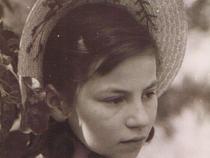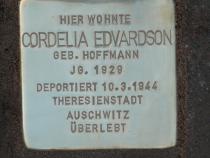Location
Eichkatzweg 33
District
Westend
Stone was laid
02 October 2008
Born
01 January 1929 in München
Deportation
on 10 March 1944
to
Theresienstadt
Later deported
to
Auschwitz
Survived
Cordelia Edvardson was born on 1 January 1929 in Munich. Her mother was the writer Elisabeth Langgässer (1899-1959), a baptised Catholic, and her father a Jewish expert in constitutional law, Hermann Heller. Elisabeth Langgässer worked as a teacher in Griesheim near Darmstadt before her daughter’s birth. Shortly afterwards, she moved with Cordelia to Berlin. In 1935 she married the non-Jewish philosopher Wilhelm Hoffmann and she and her daughter moved in with him. Their house, dubbed “Eichkatznest”, was in Eichkamp, a cooperative-built estate near Grunewald. Elisabeth Langgässer was classified by the Nazis as living in a “privileged mixed-race marriage”; her daughter Cordelia was classified as Jewish. In 1938 she gave birth to another daughter; two more followed in 1940 and 1942 respectively.
Cordelia was a serious, reserved child. From 1939 she was increasingly socially marginalised; her ancestry documents were completed in 1940. Forced to wear a yellow star from 1941, she went to live with friends aged 12 so as not to endanger the family. Her mother tried to get her to safety in Switzerland or Brazil but was not able to obtain the necessary visas. By November 1942 it was clear that Cordelia would not be able to emigrate. However, Elisabeth Langgässer managed to have her adopted by a Spanish couple. Her name was changed to Cordelia Garcis-Scouvart, and she was protected for a short time.
In her book “Burned Child Seeks the Fire” (published in 1984 in Sweden), Cordelia Edvardson describes the fateful day she appeared before the Gestapo. Her mother was threatened with charges of high treason for helping “a Jewess dodge the race laws” by having her daughter adopted. Cordelia, now aged 14, was forced to sign a document certifying dual nationality. Her refusal would have meant food rationing for the family and their house being marked with a yellow star. Soon afterwards the Gestapo came for Cordelia and sent her to the Jewish hospital at Iranische Strasse, which served as an assembly camp at the time.
In autumn 1943 Cordelia was deported to Theresienstadt. Wilhelm Hoffmann refused to divorce his non-Aryan wife and was made to perform forced labour for Organisation Todt as a consequence. Elisabeth Langgässer also performed forced labour. In 1944, she received the news that her daughter Cordelia had been deported to Auschwitz.
Cordelia was given the prisoner number A3709. Initially she worked on the light bulb production line; later as a typist, probably for the notorious concentration camp doctor Joseph Mengele. In spring 1945, aged 16 and seriously ill, she managed to escape to Sweden on one of the Swedish Red Cross’s White Buses (a rescue operation led by Folke Bernadotte). In Sweden she underwent psychoanalysis in an attempt to get over the trauma of her past. In the same year, Elisabeth Langgässer’s novel “Das unauslöschliche Siegel” (The Indelible Seal) was published, which was acclaimed all over the world. Yet something within her had been irrevocably lost. It was not until 1949, one year before her sudden death, that she saw Cordelia again.
In Sweden, Cordelia Edvardson became a successful journalist, married and had four children. She moved to Israel during the 1974 Yom Kippur War to work as a foreign correspondent for the Swedish newspaper Svenska Dagbladet. She returned to Stockholm in 2006. She made a documentary film, “The Girl from Auschwitz”, in which she not only proved herself an unsentimental chronicler of her own turbulent life but also a critical observer of Israeli settlement and occupation policy.
She was surprised to hear that a Stolperstein was being laid in Eichkamp, saying: “…to think that anyone in Eichkamp still thinks about me”. She died on 29 October 2012, aged 83, in Stockholm. As well as her autobiographical novel “Burned Child Seeks the Fire” (Beacon Press 1998, awarded the Geschwister Scholl Prize for literature), she also published “Die Welt zusammenfügen” (1989) and a book of poetry, “Jerusalems Lächeln” (1991). In 2001 she received the Royal Prize of the Swedish Academy. She wrote in Swedish because she had, as she said in an interview, “been robbed” of the German language.
Cordelia was a serious, reserved child. From 1939 she was increasingly socially marginalised; her ancestry documents were completed in 1940. Forced to wear a yellow star from 1941, she went to live with friends aged 12 so as not to endanger the family. Her mother tried to get her to safety in Switzerland or Brazil but was not able to obtain the necessary visas. By November 1942 it was clear that Cordelia would not be able to emigrate. However, Elisabeth Langgässer managed to have her adopted by a Spanish couple. Her name was changed to Cordelia Garcis-Scouvart, and she was protected for a short time.
In her book “Burned Child Seeks the Fire” (published in 1984 in Sweden), Cordelia Edvardson describes the fateful day she appeared before the Gestapo. Her mother was threatened with charges of high treason for helping “a Jewess dodge the race laws” by having her daughter adopted. Cordelia, now aged 14, was forced to sign a document certifying dual nationality. Her refusal would have meant food rationing for the family and their house being marked with a yellow star. Soon afterwards the Gestapo came for Cordelia and sent her to the Jewish hospital at Iranische Strasse, which served as an assembly camp at the time.
In autumn 1943 Cordelia was deported to Theresienstadt. Wilhelm Hoffmann refused to divorce his non-Aryan wife and was made to perform forced labour for Organisation Todt as a consequence. Elisabeth Langgässer also performed forced labour. In 1944, she received the news that her daughter Cordelia had been deported to Auschwitz.
Cordelia was given the prisoner number A3709. Initially she worked on the light bulb production line; later as a typist, probably for the notorious concentration camp doctor Joseph Mengele. In spring 1945, aged 16 and seriously ill, she managed to escape to Sweden on one of the Swedish Red Cross’s White Buses (a rescue operation led by Folke Bernadotte). In Sweden she underwent psychoanalysis in an attempt to get over the trauma of her past. In the same year, Elisabeth Langgässer’s novel “Das unauslöschliche Siegel” (The Indelible Seal) was published, which was acclaimed all over the world. Yet something within her had been irrevocably lost. It was not until 1949, one year before her sudden death, that she saw Cordelia again.
In Sweden, Cordelia Edvardson became a successful journalist, married and had four children. She moved to Israel during the 1974 Yom Kippur War to work as a foreign correspondent for the Swedish newspaper Svenska Dagbladet. She returned to Stockholm in 2006. She made a documentary film, “The Girl from Auschwitz”, in which she not only proved herself an unsentimental chronicler of her own turbulent life but also a critical observer of Israeli settlement and occupation policy.
She was surprised to hear that a Stolperstein was being laid in Eichkamp, saying: “…to think that anyone in Eichkamp still thinks about me”. She died on 29 October 2012, aged 83, in Stockholm. As well as her autobiographical novel “Burned Child Seeks the Fire” (Beacon Press 1998, awarded the Geschwister Scholl Prize for literature), she also published “Die Welt zusammenfügen” (1989) and a book of poetry, “Jerusalems Lächeln” (1991). In 2001 she received the Royal Prize of the Swedish Academy. She wrote in Swedish because she had, as she said in an interview, “been robbed” of the German language.




